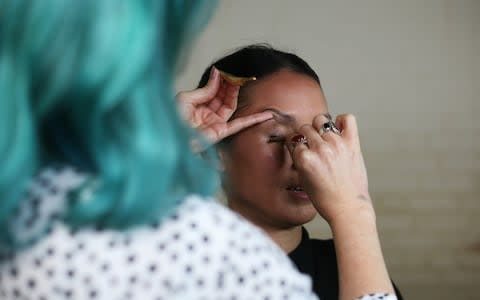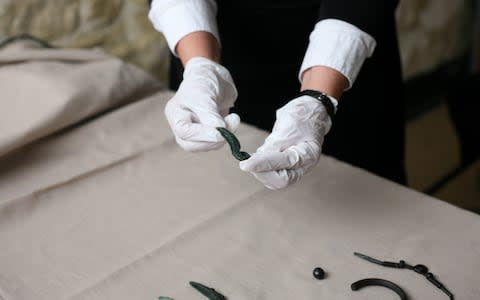Here's another thing the Romans did for us; women's make up

At first glance they may not seem that significant, but these small objects can now be added to the long list of answers to the question ‘what have the Romans ever done for us?’
In short, given us makeup.
Researchers have established for the first time the way women in Roman Britain applied their makeup.
They say the discovery throws new light on everyday life at the time and shows how the introduction of foreign techniques by the Romans literally ‘changed the face of Britain’.
These copper alloy objects, discovered amid the ruins of Wroxeter Roman City in Shropshire around 100 years ago, were first thought to be items of jewellery worn as decoration by the town’s women.
But following closer examination experts at English Heritage have now established they were in fact used as make-up applicators to put on a form of mascara and eye-shadow made from chemicals and natural dyes.
The Ancient Britons, Scots and Picts may have worn body and face paint for battle, but Roman make up was rather more subtle, designed to emphasise natural beauty rather than intimidate the enemy.

A woman, or her servant, would use the specially shaped metal objects much like a mortar and pestle, to grind materials such as charcoal into a smooth paste before applying it to the eyebrows to emphasise the eyes, a style borrowed from the Egyptians and introduced to Britain by the Roman colonisers.
Cameron Moffett, English Heritage’s collections curator, said: “Being able to re-identify these pendants as cosmetic sets is hugely important to our understanding of the women who lived and worked at Wroxeter Roman City. These small objects literally changed the face of Britain.”
Known as cosmetic grinders, the small mortar and pestle sets could be hung from a delicate cord, a feature which led to them being initially identified as decorative pendants.
However, following closer examination of their delicate shape and size, Ms Moffett and her team now believe they were cosmetic sets developed in 1st Century AD Britain in response to notions of personal beauty imported from the Mediterranean and more distant Roman provinces.

English Heritage says their discovery casts new light on the daily habits of women in Roman Britain.
Ms Moffett added: “When we think of the Roman period, conversation is often dominated by the masculine realms of influence, from Emperors and politics to battle tactics, but of course women played a key role.
“It’s these functional, everyday items that really paint a picture of relatable women, to whom make-up was wholly accessible, following the trends of the time and using tools so similar to the ones we use today.
“It was the Romans who introduced this sort of makeup for women and it was widely adopted by the native female population. The habit continued until the fall of the Roman Empire when the spread of Christianity led to very different ideas about female modesty.”
To accompany its reassessment of the objects, which are going on display for the first time at Wroxeter Roman City from Wednesday, English Heritage has released a tutorial on YouTube showing the techniques which would have been used by women in Roman Britain to apply make-up using the applicators.
Taking inspiration from known images of the Empress Julia Domna, who with her husband Septimius Severus spent three years in York in 3rd century AD, the tutorial demonstrates how to apply eyeliner using a replica cosmetic grinder.
The videos are presented by fashion historian Amber Butchart and makeup artist Rebecca Butterworth, who have previously recreate looks from history - including Elizabeth I at Kenilworth Castle in Warwickshire, Queen Victoria at Osborne on the Isle of Wight, and the Georgians at Kenwood House in London.
Wroxeter, or Viriconium as it was called by the Romans, was once the fourth largest city in Roman Britain, with bath houses, markets and a thriving forum.

 Yahoo News
Yahoo News 